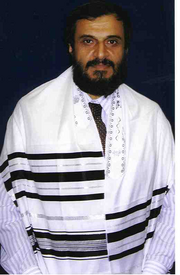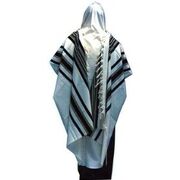A tallit (Hebrew: טַלִּית) (taleth[1] or talet[2] in Sephardic Hebrew and Ladino) (tallis,[3] talleisim,[4] tallism,[5] or tallithim[5] in Ashkenazic Hebrew and Yiddish) is a Jewish prayer shawl. A tallit is worn during the morning prayers (Shacharit) on weekdays, Shabbat and holidays. The tallit has special twined and knotted fringes known as tzitzit attached to its four corners. The tallit can be made of any materials except a mixture of wool and linen interwoven which is strictly prohibited by the Torah. Most traditional tallitot (plural of tallit) (tallesim in Ashkenazic Hebrew) are made of wool.

Jewish prayer shawl Tallit Tallis 101 JewU 1 Rabbi Jonathan Ginsburg
Biblical commandment[]
The Bible does not command wearing of a unique prayer shawl or tallit. Instead, it presumes the people to already use an outer garment of some type to cover themselves and instructs them to add fringes (tzitzit) to the 4 corners of these (Numbers 15:38, Deuteronomy 22:12). These passages do not specify tying particular types or numbers of knots in the fringes. Nor do they specify a gender division between men and women, or between native Israelite/Hebrew people and those assimilated by them. The commandment was addressed to all adult Israelites and those of "the mixed multitude" that exited Egypt with them.

A man wearing the tallit
Jewish tradition added rabbinical interpretations to provide guidance and "fence" commandments to prevent unintentional transgression by believers. Rituals for donning the garment are an example of this. They are extra-biblical observances important to Jewish worship and culture.
Encyclopedia Judaica, Second Ed., Vol. 19, Som-Tn, 2007, describes the prayer shawl as "a rectangular mantle that looked like a blanket and was worn by men in ancient times." Also, it "is usually white and made either of wool, cotton, or silk." "Strictly observant Jews prefer tallitot made of coarse, half-bleached lamb's wool."
A few decades ago, the horizontal stripes which run across the narrow ends of the shawl were exclusively black. They are now (in 2009) seen in colors including: blue, maroon, white, purple, gold, silver, rainbow, pink, and combinations of colored stripes with metallic stripes.
According to the biblical commandment, a blue (Heb. תכלת , "tĕkeleth", tek·ā'·leth) thread (Heb. פתיל "pethiyl") known as "tekeleth" itself, is included in the tzitzit (Numbers 15:38).[6][7]
Strong's H8504 for "blue" defines the dye as obtained from the shell of a Mediterranean mussel: helix ianthina that provided a hue called cerulean purple. It is also defined as violet color, which is a shade between blue and purple.[8]
Various methods of knotting the fringes have evolved.[9] According to Rabbinic Judaism, the important part of the tallit is the tzitzit.[10]
Traditionally, tzitzit have 613 knots, as a reminder of the 613 commandments comprising the entire code of law. The fringes themselves - knotted or not - were commanded as a reminder not to wander from God's commandments (Numbers 15:39).
Pronunciation[]
In Modern Hebrew the word is pronounced [taˈlit], with the stress on the final syllable. In Yiddish it is [ˈtaləs], with the stress on the first syllable. The plural of tallit in Hebrew is tallitot, pronounced [taliˈtot]. The Yiddish plural is taleisim, pronounced [taˈlejsɪm].

Customs[]
In some Jewish communities a tallit is given as a gift by a father to a son, a father-in-law to a son-in-law, or a teacher to a student. It might be purchased to mark a special occasion, such as a wedding or a bar/bat mitzvah. Many parents purchase a tallit for their children at the age of 13, together with tefillin. In the Reform and Conservative movements, it is common for both men and women to wear a tallit. While many worshipers bring their own tallit to synagogue, there is usually a rack of shawls for the use of visitors and guests. At Jewish wedding ceremonies, a tallit is often used as a chuppah or wedding canopy. The tallit is traditionally draped over the shoulders, but during prayer, some cover their head with it. In the Talmudic and post-Talmudic periods the tefillin were worn by rabbis and scholars all day, and a special tallit was worn at prayer; hence they put on the tefillin before the tallit, as appears in the order given in "Seder Rabbi Amram Gaon" (p. 2a) and in the Zohar. In modern practice, the opposite order is considered more "correct". Based on the Talmudic principle of tadir v'she'ayno tadir, tadir kodem (תדיר ושאינו תדיר, תדיר קודם: lit., frequent and infrequent, frequent first), when one performs more than one mitzva at a time, those that are performed more frequently should be performed first. While the tallit is worn daily, tefillin are not worn on Shabbat and holidays.
The Kabbalists considered the tallit as a special garment for the service of God, intended, in connection with the tefillin, to inspire awe and reverence for God at prayer (Zohar, Exodus Toledot, p. 141a). The tallit is worn by all male worshipers at the morning prayer on weekdays, Shabbat, and holy days; by the hazzan (cantor) at every prayer while before the ark; and by the reader of Torah, as well as by all other functionaries during the Torah service.
Weddings[]
In many Sephardic communities, the groom traditionally wears a tallit under the chuppah (wedding canopy). In Ashkenazi communities, a more widespread custom is that the groom wears a kittel.
Burials[]
In the Diaspora, Jews are buried in a plain, wooden casket. The corpse is collected from the place of death (home, hospital, etc.) by the chevra kadisha (burial committee). After a ritual washing of the body, the body is dressed in a kittel (shroud) and then a tallit. One of the tzitzit is then cut off. In the Land of Israel, burial is without a casket, and the kittel and tallit are the only coverings for the corpse.
Additional occasions[]
In addition to the morning prayers of weeksdays, Shabbat and holidays, a tallit is also worn for Selichos in Ashkenazic communities by the prayer leader, even though it is still night.[11] A tallit is also worn at night on Yom Kippur, from Kol Nidre, which begins during the daylight hours until after the evening (Ma'ariv) service.[12]
Types of tallitot[]
Tallit katan[]
The tallit katan, or "small" tallit, is a fringed undergarment worn by Orthodox Jews. Some hasidic Jews wear a tallit katan on top of their shirts. The rules of a tallit katan are the same as that of a tallit "Gadol" in tying and materials.
Tallit gadol[]
The tallit gadol (traditionally known as tallét gedolah amongst Sephardim), or "large" tallit, is worn over one's clothing resting on the shoulders. This is the prayer shawl that is worn during the morning services in synagogue by all participants, and in many communities by the leader of the afternoon and evening prayers as well. The tallit gadol is usually woven of wool — especially amongst Ashkenazim. Some Spanish and Portuguese Jews use silk tallitot. Today some tallitot are made of polyester and cotton. Tallitot may be of any colour but are usually white with black, blue or white stripes along the edge. Sizes of tallitot vary, and are a matter of custom and preference. Some are large enough to cover the whole body while others hang around the shoulders. The neckband of the tallit, sometimes woven of silver or gold thread, is called the atarah.
From the four corners of the tallit hang fringes called tzitzit, in compliance with the laws in the Torah (Book of Numbers 15:38).
The tallit is often kept in a dedicated pouch or cloth bag, which can be quite simple or ornately decorated.
Laws of the tallit[]
Men[]
The prayer shawl is worn over one's clothes. In Sephardi communities, a tallit is worn in the synagogue by all boys and men. Among the Ashkenazim, this is less common, and in many communities it is customary to wear one only after marriage.

Rabbi Rivkin How to Put on a Tallis
Rabbi Rivkin: How to Put on a Tallis
Women[]
Historically, women have not been obligated to don a tallit, as they are not bound to positive mitzvot which are time-specific (Babylonian Talmud, tractate Kiddushin 29a), and the obligation of donning a tallit only applies by day. Still, many early authorities permit women to wear a tallit, such as Isaac ibn Ghiyyat (b. 1038), Rashi (1040–1105), Rabbeinu Tam (ca 1100–1171), Zerachya ben Yitzhak Halevi of Lunel (ca. 1125–1186), Rambam (1135–1204), R. Eliezer ben Yoel Halevi (ca 1140–ca 1225), Rashba (1235–1310), Aharon Halevi of Barcelona (b. ca 1235?), R. Yisrael Yaaqob Alghazi (1680-1761), R. Yomtob ben Yisrael Alghazi (1726–1802)). There was, however, a gradual movement towards prohibition, mainly initiated by the Medieval Ashkenazi Rabbi Meir of Rothenburg (the Maharam). The Rema states that while women are technically allowed to don a tallit it would appear to be an act of arrogance (yuhara) for women to perform this commandment (Shulkhan Arukh, O.C. 17:2 in Mappah). The Maharil (Sefer Maharil, 7) and the Targum Yonatan Ben Uziel (on Dev. 22:5) both view a talit as a “male garment” and thus find that a women wearing a talit to be in violation of the precept prohibiting a women from wearing a man's garment.
In contemporary Orthodox Judaism, there is a debate on the appropriateness of women wearing tzitzit which has hinged on whether women are allowed to perform commandments from which they are exempt. According to Rabbi Joseph Soloveitchik the issue depends on the intention with which such an act is undertaken, e.g. whether it is intended to bring a person closer to the Almighty, or for political or protest purposes. Other commentators hold that women are prohibited generally, without making an individual inquiry. The view that women donning a tallit would be guilty of arrogance is cited as applying to attempts of making a political statement as to the ritual status of the genders, particularly in the Modern Orthodox community, are generally more inclined to regard contemporary women's intentions as religiously appropriate.
Rabbi Moshe Feinstein wrote that permission is granted to every woman who wishes to fulfill even those mitzvot which the Torah did not obligate; and they indeed fulfill a mitzvah and receive the reward for the fulfillment of the commandment - and according to the custom of the Tosafot they may also say the associated blessing - for shofar, lulav. And also tzitzit are applicable for a woman who desires to wear a four cornered garment - it should be different than a man's garment - and by putting on it tzitzit, she fulfills this mitzvah.[13]
Rabbi Yisrael Yaaqob Alghazi and Rabbi Yomtob ben Yisrael Alghazi held that the observance of this mitzvah by women was not only permitted but actually commendable, since such diligence amongst the non-obligated would inspire these women's male relatives to be even more diligent in their own observance.
References[]
- ↑ Albert Memmi (1992). The Pillar of Salt. Beacon Press. p. 65. ISBN 0807083275. http://books.google.ca/books?id=iSUQ5S47FL8C&lpg=PP1&pg=PP1#v=onepage&q=&f=false.
- ↑ Jacob Rader Marcus. This I Believe: Documents of American Jewish Life. p. 269. ISBN 0876687826. http://books.google.ca/books?id=OgDXAAAAMAAJ&source=gbs_navlinks_s.
- ↑ Jennifer Heath (2008). The Veil: Women Writers on its History, Lore, and Politics. University of California Press. p. 211. ISBN 0520250400. http://books.google.ca/books?id=kqDk3IRK-4gC&lpg=PP1&pg=PP1#v=onepage&q=&f=false.
- ↑ Ilana M. Blumberg (2009). Houses of Study: A Jewish Woman Among Books. University of Nebraska Press. p. 64. ISBN 0803224494. http://books.google.ca/books?id=8VOZ_1q6TEwC&lpg=PP1&pg=PP1#v=onepage&q=&f=false.
- ↑ 5.0 5.1 Joseph Leftwich (1974). An Anthology of Modern Yiddish Literature. Walter de Gruyter. p. 338. ISBN 9027930015. http://books.google.ca/books?id=dkVDPlhjcn8C&lpg=PP1&pg=PP1#v=onepage&q=&f=false.
- ↑ Blue Letter Bible. "Numbers 15 - King James Version." Blue Letter Bible. 1996-2009. 12 Jun 2009. http://www.blueletterbible.org/Bible.cfm?b=Num&c=15&t=KJV
- ↑ http://www.tekhelet.com/ The Ptil Tekhelet Organization
- ↑ Blue Letter Bible. "Dictionary and Word Search for tĕkeleth (Strong's 8504)". Blue Letter Bible. 1996-2009. 12 Jun 2009. http://www.blueletterbible.org/lang/lexicon/lexicon.cfm? Strongs=H8504&t=KJV
- ↑ http://www.tekhelet.com/diagrams/TyingDiagramSeriesHomePage.htm Tying Guide
- ↑ http://www.judaicaquest.com/tallit
- ↑ http://books.google.ca/books?id=gISl55geRaAC&pg=RA1-PA1042&dq=Sephardi+tallis&lr=#v=onepage&q=&f=false
- ↑ http://books.google.ca/books?id=oXhBgCJjCmcC&pg=PA73&dq=ma%27ariv+tallit&lr=#v=onepage&q=ma'ariv%20tallit&f=false
- ↑ Igrot Moshe, Orech Hayim 4:49, s.v. ibra d’ika
External links[]
| This page uses content from the English Wikipedia. The original article was at Tallit. The list of authors can be seen in the page history. |
| Religion Wiki uses embedded video content from YouTube.com. We do not host or upload any videos, films, or media files. Therefore, Religion Wiki is not responsible for the accuracy, compliance, copyright, legality, decency, or any other aspect of the content of other linked sites. If you have any legal issues please contact the appropriate media file owners / host sites. |